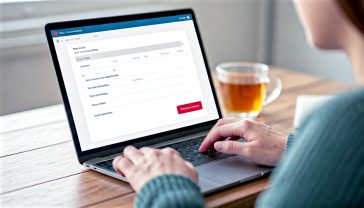The Guide to Viral Licenses: How ‘Copyleft’ Changed the Rules of Sharing
Discover the story of viral licenses, also known as ‘copyleft’. Learn how this rebellious idea powers open-source software and shapes our digital world.

This post may contain affiliate links. If you make a purchase through these links, we may earn a commission at no additional cost to you.
Ever borrowed a book from a mate, only to have them say, “Sure, but if you lend it to anyone else, you have to tell them the same thing”? You’ve just stumbled upon the core idea behind a viral license. It’s a clever, slightly cheeky concept that has quietly shaped the digital world we live in, from the software running your phone to the articles you read online.
You might think of a virus as something to avoid—a nasty bug that spreads without permission. But in the world of software and creative work, “viral” can be a force for good. A viral license, often called a ‘copyleft’ or ‘share-alike’ license, uses the machinery of copyright law to do something rebellious: instead of locking things down, it forces them to stay open.
Imagine you’ve built a brilliant piece of software, written a killer song, or designed a fantastic 3D model. You want to share it with the world, for free. But you’ve got a worry. What if some big, faceless corporation swoops in, takes your work, adds a few bells and whistles, and starts selling it for a fortune without giving anything back to the community?
That’s where a viral license comes in. It acts like a digital pay-it-forward scheme. It says, “You can use my work for free. You can change it, improve it, and build upon it. But there’s one crucial rule: if you share your new creation, you must share it under the same open terms.” Your openness becomes infectious. It spreads to every new version, ensuring the original freedom can never be taken away.
This isn’t some dusty legal footnote; it’s the beating heart of the open-source movement that powers huge chunks of the internet. It’s the philosophy behind Linux, the operating system that runs everything from supercomputers to smart fridges. It’s what allows creative communities to flourish on websites like Wikipedia.
In this guide, we’ll unpack the whole story of viral licenses. We’ll look at how they started with a rebellious programmer at MIT, explore how they work in practice, and see why they’re more important than ever in our increasingly digital lives. We’ll cut through the jargon and show you how this simple, powerful idea ensures that when something is shared freely, it stays free for everyone.
What Exactly Is a Viral License and How Does It Work?
At its simplest, a viral license is a set of rules that you attach to your work. These rules are legally binding, just like traditional copyright. But instead of saying, “You can’t copy this,” they say, “You can copy this, but only if you pass the same freedom to copy on to others.”
Think of it like a sourdough starter. You get a blob of starter from a friend (the original work). You can use it to bake your own delicious loaf (your new, modified work). But the rules of sourdough etiquette say you must keep some of that starter alive and be willing to pass it on to the next person who asks. The starter (the freedom) keeps on giving.
This “infectious” nature is why they’re called viral. Any new work that incorporates or is derived from the original licensed work is also bound by the same license terms. This is the core principle of ‘copyleft’—a playful twist on the word ‘copyright’. While copyright reserves rights for the creator, copyleft uses those same rights to ensure the work and its derivatives remain free and open for all.
The Core Mechanic: Share-Alike
The engine that drives a viral license is the share-alike clause. This is the specific legal term that enforces the pay-it-forward rule. It’s the part of the license that says any derivative works—that is, new creations based on the original—must be distributed under the same or a very similar license.
Let’s break it down with a practical example:
- The Original Work: Imagine a talented developer in Manchester, let’s call her Priya, writes a clever piece of code for managing a community garden’s planting schedule. She releases it under a popular viral license, the GNU General Public License (GPL).
- The First User: A developer in Bristol, Ben, finds Priya’s code. It’s almost perfect for his allotment association, but he wants to add a feature for tracking rainfall. He downloads the code, modifies it, and adds his new feature.
- The Viral Clause Kicks In: Because Ben’s new program is a ‘derivative work’ of Priya’s original code, the GPL’s share-alike clause applies. If Ben decides to share his improved version with other allotment groups, he must release it under the GPL as well. He can’t lock it down and sell it as his own proprietary software.
- The Chain Continues: A student in Edinburgh then takes Ben’s version and adapts it for Scottish growing seasons. She too must share her version under the GPL.
The freedom to use, study, modify, and share the software propagates from one version to the next. The “virus” of openness has spread, creating a growing pool of free and open software that everyone can benefit from.
Strong vs. Weak Copyleft: Not All Viruses Are the Same
Just as biological viruses vary in strength, viral licenses come in two main flavours: strong and weak copyleft. The difference is all about how far the “infection” spreads.
Strong Copyleft: The Full-Strength Virus
A strong copyleft license, like the widely-used GNU General Public License (GPL), is the most infectious type. It dictates that any work that is derived from or linked to the original code must also be licensed under the same strong copyleft terms.
This is a very powerful tool for ensuring that an entire software ecosystem remains open. If you have a piece of GPL-licensed code (a library, for example) and you link it into your larger, proprietary software project, the GPL’s terms can be interpreted to mean your entire project must now be released under the GPL.
- Analogy: Think of it like adding a drop of bright red paint to a can of white paint. No matter how small the drop, the entire can of paint turns pink. You can’t separate the red out again.
- Famous Example: Linux, the kernel of the operating system used by Android, countless servers, and many smart devices, is licensed under the GPLv2. This has been a key factor in its success, as it prevented companies from taking the kernel, making proprietary improvements, and closing it off.
Weak Copyleft: A Milder Strain
A weak copyleft license, like the GNU Lesser General Public License (LGPL) or the Mozilla Public License (MPL), is less aggressive. These licenses still require you to share any direct modifications to the original code under the same weak copyleft license. However, they allow you to link to that code from your own proprietary, closed-source software without your entire project becoming infected.
You only have to release the source code for the weak copyleft component itself, not your own code that uses it.
- Analogy: This is like using a publicly owned library book to help you write your own novel. You have to return the library book so others can use it, but you don’t have to give away your novel for free. You’re just using a public resource.
- Famous Example: Many software libraries are released under the LGPL. This allows commercial software developers to use these powerful, community-built tools in their own products without being forced to open-source their entire application. It’s a pragmatic compromise between total openness and commercial reality.
Understanding the difference between strong and weak copyleft is crucial for developers and businesses. Choosing the wrong one can have major legal and commercial implications. A strong copyleft license is a powerful statement of principle, designed to build a commons of free software. A weak copyleft license offers a bridge, allowing open and proprietary software to coexist more easily.
The Birth of a Rebellion: A History of Copyleft
The story of viral licenses isn’t just a legal history; it’s a tale of rebellion, idealism, and one programmer’s crusade against the locking down of software. It all begins in the hacker labs of the Massachusetts Institute of Technology (MIT) in the 1970s and 80s, with a brilliant but uncompromising figure named Richard Stallman.
The Golden Age of Hacking and Sharing
In the early days of computing, the culture among programmers, or ‘hackers’ in the original sense of the word (creative problem-solvers), was one of open collaboration. At places like MIT’s Artificial Intelligence Lab, software was seen as a shared resource, a bit like scientific knowledge. Programmers would freely share their code, improve each other’s work, and fix bugs for the good of the community. The source code—the human-readable instructions behind a program—was almost always available.
This collaborative spirit began to change in the late 1970s and early 1980s. As computers moved from university labs into businesses and homes, software became a valuable commercial product. Companies started to see source code not as something to be shared, but as a trade secret to be protected. They began distributing their software in a ‘binary-only’ format—the compiled, machine-readable version that is incredibly difficult for humans to understand or modify. They locked it down with restrictive licenses that forbade copying and modification.
For Richard Stallman, this was a moral betrayal. He tells a now-famous story about a new laser printer in the lab. The printer’s software was buggy, and it frequently jammed. In the past, Stallman or his colleagues would have simply dived into the source code, fixed the bug, and shared the improvement with everyone. But this time, the printer’s manufacturer refused to provide the source code. It was proprietary. The hackers were locked out, powerless to fix their own tools.
Stallman’s Epiphany and the GNU Project
This printer incident, and others like it, crystallised Stallman’s thinking. He saw the shift to proprietary software as an attack on the freedom of users. He believed that users should have four essential freedoms:
- The freedom to run the program for any purpose.
- The freedom to study how the program works, and change it to make it do what you wish (access to the source code is a precondition for this).
- The freedom to redistribute copies so you can help your neighbour.
- The freedom to distribute copies of your modified versions to others.
In 1983, Stallman announced an ambitious plan to fight back. He would create an entire operating system that was completely free from proprietary code. It would be a clone of the popular Unix system, but it would respect user freedom. He called it GNU, a recursive acronym for “GNU’s Not Unix.”
To protect this new ecosystem of free software, Stallman needed a legal tool. He needed to turn copyright law on its head.
The Invention of Copyleft and the GPL
Working with lawyers, Stallman devised a brilliant legal hack. He would release the GNU software under a license of his own creation. This license would use his copyright on the software to grant everyone the four essential freedoms. But it would include a crucial condition: the share-alike clause.
He called this concept copyleft. In 1989, he formalised it in the first version of the GNU General Public License (GPL). The GPL was the world’s first strong copyleft license and the most powerful legal expression of Stallman’s philosophy. It was designed to be viral, ensuring that the freedoms granted by the GNU Project could not be stripped away by others.
The GPL was a declaration of independence for the free software movement. It provided a legal framework that allowed a community to build and share software, safe in the knowledge that their collective work would remain free for all to use and improve, forever. It was this license that would eventually provide the legal foundation for thousands of projects, including one of the most important pieces of software ever written: the Linux kernel.
The Impact of Viral Licenses on Our Digital World
It’s easy to think of software licenses as boring legal documents, but the invention of copyleft has had a profound and lasting impact on technology, culture, and business. The viral nature of licenses like the GPL didn’t just protect a few projects; it kickstarted a global movement that has reshaped how we create and share digital information.
Powering the Open-Source Revolution
The most significant impact of viral licenses is the creation of the open-source software ecosystem. While ‘free software’ (Stallman’s term) is about the moral philosophy of user freedom, ‘open source’ is a more pragmatic term, focused on the practical benefits of a collaborative development model. Viral licenses are the legal backbone of this model.
- The Linux Kernel: In 1991, a Finnish student named Linus Torvalds created a new operating system kernel, which he called Linux. He famously released it under the GPLv2. This was a pivotal decision. The GPL ensured that any company building on Linux, from Red Hat to Google, had to contribute their changes to the kernel back to the public. This created a virtuous cycle of development, with thousands of developers and companies around the world collaborating on a single, shared project. Today, Linux dominates server computing, powers the entire Android mobile ecosystem, and runs a huge number of devices, from your home router to the London Stock Exchange. None of this would have been possible without the protective, viral nature of the GPL.
- A Universe of Tools: Beyond Linux, countless essential tools that run the modern internet are protected by viral licenses. GCC, the compiler used to build most open-source software; WordPress, the platform that powers over 40% of the web; and Git, the version control system used by millions of developers, are all licensed under the GPL. These projects created a vast commons of high-quality, free software that anyone can use to build new things.
Changing Business Models
For years, the software industry was dominated by a simple model: write proprietary software, sell licenses, and protect your source code at all costs. Companies like Microsoft became giants with this model. Viral licenses seemed like a direct threat to this way of doing business. How can you make money if you have to give your code away?
But smart businesses learned to adapt and even thrive in a copyleft world.
- Services and Support: Companies like Red Hat (now part of IBM) pioneered a successful business model built around a GPL-licensed operating system. They don’t sell the software itself (you can download it for free). Instead, they sell support, consulting, and enterprise-grade services to companies that rely on it. Their expertise is the product, not the code.
- Open Core Model: This is a hybrid approach. A company releases a ‘core’ version of its product under an open-source license (often a weak copyleft or permissive one) to build a community and encourage adoption. They then sell proprietary add-ons, enterprise features, or a cloud-hosted version that includes extra functionality. GitLab and Elasticsearch are well-known UK-founded examples that have used this model.
- Hardware Sales: Google gives away the Android operating system, which is built on the GPL-licensed Linux kernel, for free to phone manufacturers. They make their money not from selling Android licenses, but from the Google services (like the Play Store, Maps, and Search) that run on top of it, and the vast amounts of data that generates.
Beyond Software: Creative Commons and the Culture of Sharing
The radical idea of copyleft soon escaped the world of programming and began to influence other creative fields. The legal framework was so powerful that artists, writers, musicians, and educators wanted something similar for their work.
In 2001, a group of legal scholars, including Lawrence Lessig, founded the Creative Commons (CC). They created a set of simple, easy-to-understand licenses inspired by the GPL, but designed for creative works like photos, music, and text.
The most viral of these is the Creative Commons ShareAlike (CC BY-SA) license. It’s the cultural cousin of the GPL. It lets people copy, share, and remix a work, even commercially, as long as they credit the original creator and release their new work under the same CC BY-SA license.
- Wikipedia: The world’s largest encyclopedia is a monumental testament to the power of a viral license. All of the text on Wikipedia is licensed under CC BY-SA. This means you can reuse and adapt its content freely, but you must share your new version under the same terms, ensuring that this incredible pool of human knowledge can never be locked down.
- Flickr and the Creative Commons: The photo-sharing site Flickr was an early adopter of Creative Commons, allowing photographers to easily license their work for others to use. This created a huge library of high-quality images available under ShareAlike terms, fuelling blogs, presentations, and creative projects around the world.
The “share-alike” philosophy has fundamentally changed how we think about creativity and knowledge. It has provided a legal and ethical framework for a more collaborative and open culture, proving that sharing doesn’t have to mean giving up control entirely. It can mean setting the terms for a better, more equitable kind of sharing.
The Practical Side: Using and Complying with Viral Licenses
So, you’re a developer, a creator, or a business owner, and you’ve encountered a piece of work under a viral license. What do you actually need to do? While the philosophy is inspiring, the day-to-day reality is about compliance. Getting it wrong can lead to legal headaches and public relations disasters.
For Developers and Coders
If you’re a programmer, viral licenses are a fundamental part of your world. Here’s a simple breakdown of what you need to keep in mind.
- Always Check the License: Before you use any third-party code, library, or framework in your project, the very first step is to identify its license. It could be in a file named
LICENSE,COPYING, or in the project’sREADME. Don’t assume anything is free to use just because it’s on GitHub. - Understand the “Distribution” Trigger: The rules of a copyleft license, like the GPL, typically kick in when you distribute the software to others. If you’re just using a GPL-licensed tool internally within your company and never give the software to anyone outside, you generally don’t have to release your source code. The same goes for software running on a web server that users interact with via a browser (though some newer licenses, like the AGPL, were created to close this “loophole”). Distribution is the key event.
- Strong vs. Weak Matters Hugely:
- If you link your proprietary code against a strong copyleft (GPL) library, your entire application is now considered a derivative work. If you distribute it, you must release the source code for your entire application under the GPL. This is why many companies have strict policies against using GPL code in their commercial products.
- If you link against a weak copyleft (LGPL) library, you only need to release the source code for any changes you made to that library. Your own proprietary code can remain closed. You just need to make it possible for a user to replace the LGPL library with a different version if they wish.
- Keep Meticulous Records: In any serious software project, you must keep a record of all the open-source components you use and their licenses. This is often called a Software Bill of Materials (SBOM). Tools like FOSSA, Snyk, and Black Duck can automate this process, scanning your code for open-source dependencies and flagging potential license conflicts.
For Creators (Writers, Artists, Musicians)
If you’re working with content licensed under Creative Commons ShareAlike (CC BY-SA), the rules are generally simpler but the principle is the same.
- Give Credit (Attribution): The “BY” part of the license means you must always credit the original creator. This usually involves stating their name, a link to their work, and a link to the CC license itself.
- Share Under the Same License (ShareAlike): The “SA” part is the viral clause. If you adapt the work—for example, by using a CC BY-SA photo in a collage, or remixing a CC BY-SA song—you must release your new creation under the CC BY-SA license as well.
- What Counts as a “Derivative Work”? This can be a grey area. Using a collection of CC BY-SA photos in a blog post doesn’t necessarily mean your entire blog has to be CC BY-SA. The blog is a ‘collective work’. However, if you edit one of those photos significantly (e.g., colourising it, adding elements), your new edited image is a derivative work and must be shared alike. Common sense is a good guide here.
Common Pitfalls and Misconceptions
- “It’s on the internet, so it’s free.” This is the most dangerous misconception. Everything created is automatically under copyright by default, even if it doesn’t have a © symbol. Unless there is a clear license stating otherwise, you have no right to use it.
- “I’m not making any money, so it’s fine.” Most copyleft licenses, including the GPL and CC BY-SA, apply regardless of whether you are using the work commercially or not. Your obligations are triggered by distribution and modification, not by profit.
- “I’ll just copy and paste a small snippet.” Even a small amount of code or text can be subject to the license of the whole. There’s no clear “x lines of code is fine” rule. If it’s a creative and non-trivial part of the original work, the license applies.
Compliance isn’t about being scared; it’s about being respectful of the creator’s wishes and the legal framework that allows the open-source and creative commons to thrive. When in doubt, the golden rule is to stick to more permissive licenses (like MIT or Apache) which don’t have a share-alike clause, or consult with a legal professional who understands software licensing.
The Future of Viral Licenses: Debates and New Frontiers
The world of technology and creativity never stands still, and the role of viral licenses continues to evolve. While their legacy is secure, their future is a subject of heated debate, touching on everything from the rise of cloud computing to the ethics of artificial intelligence.
The Rise of Permissive Licenses
In recent years, there has been a noticeable shift in the open-source world away from strong copyleft licenses like the GPL towards more permissive licenses like the MIT License and the Apache License 2.0.
These licenses are very simple. They basically say, “Do whatever you want with this code, just don’t sue me.” They don’t have a share-alike clause. This means a company like Apple or Google can take MIT-licensed code, incorporate it into their proprietary operating systems (iOS or Android), and have no obligation to share their changes.
Why the shift?
- Corporate Friendliness: Big tech companies are huge contributors to open source, but they are often wary of the GPL’s viral nature. By releasing code under a permissive license, they encourage maximum adoption, including by commercial competitors, without the legal complexities of copyleft.
- Simplicity and Pragmatism: For many developers, the goal is simply to get their code used by as many people as possible. A permissive license removes any friction for businesses, making the code more attractive.
- The Cloud Loophole: The GPL was designed for a world where software was distributed to users’ computers. In the age of cloud computing, the software often runs on the company’s servers and users interact with it through a browser. Since the software isn’t being “distributed” to the user, the GPL’s share-alike clause is arguably not triggered. This is known as the “SaaS loophole.”
Richard Stallman and the Free Software Foundation saw this coming and created the Affero General Public License (AGPL). It’s a modified version of the GPL with an extra clause that closes the cloud loophole. The AGPL states that if you run a modified version on a server and let users interact with it over a network, you must make the source code available. Many companies are even more reluctant to touch AGPL code than GPL code.
The Ethical Source Movement
A newer debate is emerging around the idea of Ethical Source licenses. This movement argues that standard open-source licenses are “freedom-blind.” They grant freedom to everyone, including those who might use the software for purposes the creator finds unethical, such as human rights abuses, environmental destruction, or military applications.
Proponents are creating new licenses, like the Hippocratic License, that add a “do no harm” clause. These licenses forbid the use of the software in certain ethically questionable contexts.
This is a controversial idea. Many traditional open-source advocates argue that restricting who can use the software goes against the core principle of open source (specifically, “Freedom 0” – the freedom to run the program for any purpose). They believe that the license should not be a tool for imposing the author’s personal morality. This debate is ongoing and highlights the tension between absolute freedom and social responsibility in the tech world.
AI, Data, and the Next Generation of Sharing
The rise of Artificial Intelligence (AI) presents a whole new set of challenges and questions for licensing.
- Training Data: AI models, especially large language models like GPT, are trained on vast amounts of text and images scraped from the internet. A lot of this data is copyrighted or licensed under copyleft terms. Is training an AI on this data a form of “distribution” or a “derivative work”? The courts are still figuring this out.
- Model Weights: When an AI is trained, the result is a set of “weights”—billions of numbers that represent the model’s learned knowledge. Should these weights be considered a form of source code? Can they be licensed? Some organisations are now releasing open-source AI models with licenses that cover not just the code, but the model weights too.
- The Future of Openness: The spirit of copyleft—ensuring that knowledge and tools remain accessible and improvable by the community—is incredibly relevant in the age of AI. As AI becomes more powerful and central to our society, there is a growing movement arguing that these systems should not be the exclusive property of a few giant corporations. Viral licenses could be a powerful tool to ensure that the benefits of AI are shared more widely.
The simple idea that began with Richard Stallman’s frustration over a printer has grown into a global conversation about freedom, control, and collaboration. Viral licenses remain a potent, if sometimes controversial, tool. They challenge us to think about what it means to share in a digital age and force us to decide what kind of open and collaborative future we want to build.
Further Reading:
- Free Software Foundation: The organisation founded by Richard Stallman, the philosophical home of the copyleft movement. https://www.fsf.org/
- Open Source Initiative (OSI): A pragmatic organisation that certifies licenses as “open source” and promotes the benefits of the open-source development model. https://opensource.org/
- Creative Commons: The go-to resource for understanding and using licenses for creative works beyond software. https://creativecommons.org/
- Choose a License: A helpful, plain-English guide from GitHub to help you choose an open-source license for your project. https://choosealicense.com/
- The Guardian’s Technology Section: For ongoing coverage of technology trends, including open source and digital rights, from a respected British perspective. https://www.theguardian.com/uk/technology






